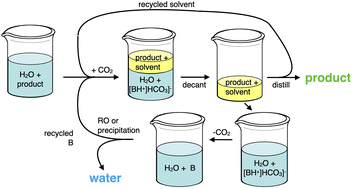A CO2-responsive method for separating hydrophilic organic molecules from aqueous solutions: solvent-assisted switchable water
Abstract
1,3-Propanediol (PDO) can be produced by fermentation of glycerol, but the post-fermentation separation of the PDO from the aqueous medium is hampered by the low volatility and high hydrophilicity of PDO. A new method for separating hydrophilic products from water is proposed, called Solvent-Assisted Switchable Water (SASW). In this method, a hydrophilic water-miscible extraction solvent such as isopropanol is used to extract PDO from the aqueous phase. A CO2-switchable ionogen (N,N,N′,N′-tetramethylbutane-1,4-diamine, TMBDA), which forms a bicarbonate salt in the presence of CO2, salts out the isopropanol to prevent it from merging with the aqueous phase. The yield of extracted PDO was up to 73%, but the recovered PDO contained a significant amount of water and amine, showing that the selectivity of the extraction still has room for improvement. This new extraction technique might find utility in the extraction of hydrophilic products from water, if further development of the method leads to better extraction selectivity.



 Please wait while we load your content...
Please wait while we load your content...